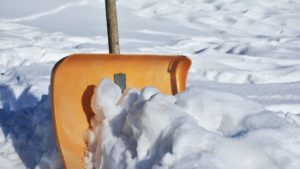The unofficial start to winter has begun with snowfalls and freezing temperatures reaching much of the nation. Though it’s not at the top of everyone’s mind, this time of year it’s important to be aware of stormwater management. Stormwater can not only cause flooding, but it often contains pollutants that end up in local rivers, streams and oceans, contaminating aquatic life and fresh drinking water, as well as the air we breathe. EP Henry’s Permeable Pavers are a viable system available to reduce stormwater runoff.
The pavers work to direct the water to filter back into the surrounding soil, while also slowing the formation of ice in pathways.
But permeable pavers aren’t the only way to protect our environment. Read on for three facts you should know about stormwater management during the winter:
Over-salting roads and walkways can be toxic for the environment.

It is important to remember to use rock salt in moderation when de-icing your patio, walkways or driveway. An excessive amount often ends up in storm drains and streams, affecting aquatic life and fresh water sources with high chloride concentrations. To reduce the amount of rock salt on your property, remove snow with a shovel or snow blower before applying your deicer. There are also environmentally friendly alternatives to rock salt, such as acetates, potassium chloride, and magnesium chloride.Tip:For extra traction on your property with an environmentally friendly spin, spread some bird seed on your iced walkway. The birds will appreciate the snack and it will give you the gravel-like surface you need to be safe.
Improperly disposing of snow and ice increases impacts of flooding and pollution.
Dumping snow and ice in or near a body of water – or directly on top of storm drains -damages water quality and can cause navigational hazards when the snow freezes. If possible, it is always best to avoid creating snow piles near roadways as it will cause the melted snow to run down into drains or even nearby streams. In addition to endangering waterways, snow piles collect toxins from cars and other debris, which upon melting are released into the air we breathe. Another not-so-fun fact, piling snow onto rain gardens can also be harmful-when the snow melts, the excessive saturation could damage the plants. Tip: If you are using a plow, check your city’s guidelines for removing snow so that it is safe for the public and environment.
So where you can safely discard all that snow?

The middle of your yard is generally a safe place to throw your snow, as this keeps it away from plants, storm drains and roads. To avoid personal accidents, it’s a good idea to be careful not to create any snowy obstacles along pathways to the garage, garbage bins, or other common routes around the house. Tip: To quicken the melting process, take notice of where the sun hits during the day and make your snow pile accordingly.
While the snow and ice can cause added trouble to our daily lives and our commutes, it’s important not to forget about its effect on our environment. Be mindful of snow’s negative potential. Don’t forget that adding EP Henry Permeable Pavers to an already solid stormwater plan will make your home environmentally friendly and safer for your family.